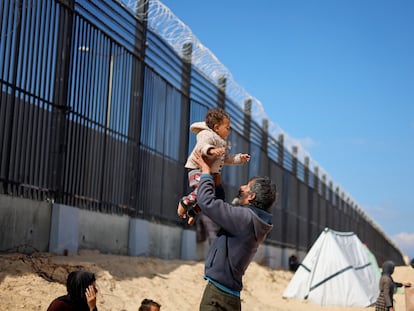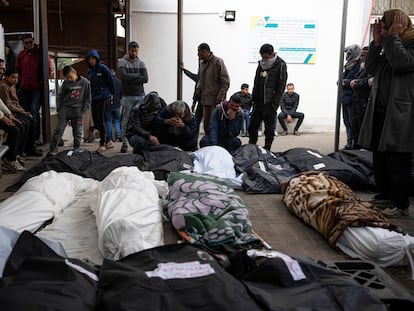Israeli army begins evacuating the largest hospital in southern Gaza
Hundreds of forcibly displaced people have left the besieged Nasser medical center in Khan Younis. Meanwhile, Prime Minister Benjamin Netanyahu makes returning to the negotiating table conditional on Hamas delivering a new proposal for a ceasefire

After besieging it for a week, the Israeli army began this Wednesday to evacuate Nasser Hospital, the main medical center still operational in the Gaza Strip, located in the southern city of Khan Younis. In images and videos recorded from its surroundings and shared on social media, hundreds of people can be seen leaving the hospital carrying what little belongings they have left — and some holding white flags — after Israeli troops warned, via loudspeakers and drones, that they intended to raid the facility.
The director general of the World Health Organization (WHO), Tedros Adhanom Ghebreyesus, expressed his “alarm” at the situation in Nasser, which he defined as the “backbone of the health system in southern Gaza,” where the vast majority of Gazans are concentrated after their forced displacement from the north. In a message on the social network X, Ghebreyesus wrote: “Hostilities have reportedly destroyed storage facilities for medical equipment and supplies. Access to the hospital remains obstructed — there is no safe corridor for those in need. Two WHO missions have been denied [access to the hospital] in the last four days and we lost touch with the hospital’s personnel.”
According to the Israeli army, their intention is not “to evacuate patients and medical personnel” and they have opened a “safe route” for the displaced Gazans to move in the direction of the “humanitarian zone.” The spokesman for the Ministry of Health of the Hamas government in Gaza, Ashraf Al-Qudra, has accused the Israeli military of “forcing thousands of displaced persons, families of medical personnel and patients who cannot move” to leave the center, despite “being threatened by extreme danger.”
The hospital has become a makeshift shelter for displaced people. The estimated thousands of people inside have spent the past few days in fear of Israeli tanks and gunmen stationed nearby. According to health authorities in the Gaza Strip, at least three civilians have been killed. Doctors Without Borders, which has local staff there, reported at the end of January that some 300 patients remained in the hospital unable to be evacuated because of the lack of ambulances and the danger involved. It is a similar situation to that experienced in November by the Al Shifa Hospital in Gaza City, under which Israel claimed a Hamas command and operations center was located. After storming the medical center, Israeli forces found no such thing.
“Intense shelling”
The Palestine Red Crescent Society also reported Wednesday “intense shelling” around another hospital in Khan Younis, Al-Amal, which was damaged. Earlier, the organization had reported the arrest there of nine of its staff and that soldiers broke medical equipment and took laptops in the raid.
The Israeli army claims that the hospitals hide access points to the underground network of tunnels used by Hamas. In the underground passages — which Israeli troops are blowing up or flooding with water from the Mediterranean Sea — the army hopes to find some of the 134 hostages (at least 31 of them dead) remaining in Gaza, after the rescue on Tuesday of two of them, with dual Argentine and Israeli nationality. They also hope to find Yahya Sinwar, the Hamas leader in Gaza whose assassination would suppose a victory for Prime Minister Benjamin Netanyahu after more than four months of war.
This Monday, the Israel Defense Forces (IDF) released a video featuring Sinwar. It was recorded in the early days of the current conflict, beginning on October 7, and shows him with his back turned, moving through a tunnel with his wife and children. On the same day, the head of Israel’s Mossad met in Cairo with Qatari, Egyptian and American mediators to negotiate the exchange of hostages for the release of Palestinian prisoners and a ceasefire of at least six weeks. For the time being, though, he will not return to the negotiating table.
Netanyahu on Tuesday ordered the delegation to stay in Israel because it “did not receive any new proposal from Hamas” in Cairo after the prime minister flatly rejected the militia’s last plan. Hamas had proposed to negotiate a definitive end to the war during 135 days of ceasefire in which up to 1,500 Palestinian prisoners would regain their freedom in exchange for the release of all hostages. Netanyahu rejected it outright, calling it “delusional.” “A change in Hamas’ positions will allow negotiations to move forward,” he said in a statement.
Meanwhile, the daily skirmishes between Israel and militias in Lebanon have intensified. Wednesday morning, a barrage of rockets launched from Lebanon killed one female soldier and wounded eight others at a military base in Israel. The attack is not only unusual because most of the projectiles appear to be aimed at unpopulated areas, to avoid escalation, but also because it hit a military base in the town of Safed, which has not been evacuated and is just 8 miles from the border. No armed group has claimed responsibility for the attack. The Israeli army reacted with a series of bombings, also close to the border, killing at least four people: two children, a woman and a Hezbollah militiaman.
Sign up for our weekly newsletter to get more English-language news coverage from EL PAÍS USA Edition
Tu suscripción se está usando en otro dispositivo
¿Quieres añadir otro usuario a tu suscripción?
Si continúas leyendo en este dispositivo, no se podrá leer en el otro.
FlechaTu suscripción se está usando en otro dispositivo y solo puedes acceder a EL PAÍS desde un dispositivo a la vez.
Si quieres compartir tu cuenta, cambia tu suscripción a la modalidad Premium, así podrás añadir otro usuario. Cada uno accederá con su propia cuenta de email, lo que os permitirá personalizar vuestra experiencia en EL PAÍS.
¿Tienes una suscripción de empresa? Accede aquí para contratar más cuentas.
En el caso de no saber quién está usando tu cuenta, te recomendamos cambiar tu contraseña aquí.
Si decides continuar compartiendo tu cuenta, este mensaje se mostrará en tu dispositivo y en el de la otra persona que está usando tu cuenta de forma indefinida, afectando a tu experiencia de lectura. Puedes consultar aquí los términos y condiciones de la suscripción digital.
More information
Archived In
Últimas noticias
The new victims of the Republican war on Obamacare: Millions hit by soaring health insurance premiums
A country divided on migrant rights: Some US states expand protections while others restrict them
Venezuela authorizes the release of another 87 political prisoners
There is as much life left to discover on planet Earth as that which is already known
Most viewed
- David King, chemist: ‘There are scientists studying how to cool the planet; nobody should stop these experiments from happening’
- Reinhard Genzel, Nobel laureate in physics: ‘One-minute videos will never give you the truth’
- Oona Chaplin: ‘I told James Cameron that I was living in a treehouse and starting a permaculture project with a friend’
- Sinaloa Cartel war is taking its toll on Los Chapitos
- The Interoceanic Train, the Mexican alternative to the Panama Canal











































